Widgetized Section
Go to Admin » Appearance » Widgets » and move Gabfire Widget: Social into that MastheadOverlay zone
Educating Your Instincts
When I first started studying the martial arts almost 40 years ago, I realized that the toughest part of real self-defense is recognizing an attack quickly enough to be able to “do your technique.” With enough training and practice, reflexive actions are possible, but reflexes have to be based on recognition of a specific stimulus. And the more techniques you rely on, the harder it is to program reflexive responses.
Practical self-defense is simple, direct, and effective. Similarly, good self-defense techniques should share a number of basic qualities that allow them to be applied easily and spontaneously, even under the stress of a real attack. The qualities you should look for in a good self-defense technique should include the following:
Simple: Techniques requiring multiple, complicated movements are difficult to learn and even more difficult to apply spontaneously against a sudden attack. Simple, direct techniques are a much better choice.
Instinctive: People confronted with a sudden, violent attack will respond first with instinct. Reactions like the “startle response” are very powerful instincts that are very difficult to “un-train.” Rather than trying to ignore or bypass them, accept them—and the defensive functions they provide—and base your technique on the structure they provide. One example of this is the instinct to extend your arms to try to hold an attacker away from you. As a sustained push, it is not very effective; however, as an explosive check or strike with both hands, it can be a very powerful defense.
Powerful: To stop an attacker effectively, you need to hurt him. That means that your technique must be powerful and it must hit a vulnerable target. Learn to harness the natural power of your body and make the best use of your strongest weapons—like kicks.
Creates an Opportunity for Escape: The ultimate goal of self-defense is not to “win,” it is to escape the situation safely. The easiest way to do that is to destroy your attacker’s ability to follow you and continue his attack. To do this, you should target the attacker’s eyes, throat, and legs. Remember: “If he can’t see, can’t breathe, or can’t stand up, he can’t fight.”
Works in Confined Quarters: An attacker will target you when the conditions favor him and do not favor you. In many cases, he will try to attack when you are stuck in a confined area with nowhere to run and little room to maneuver. For example, hallways, elevators, parking lots, and similar areas limit your options when it comes to footwork and techniques that require a lot of room to execute. Therefore, your techniques should be compact and must work well even in very confined areas.
Versatile: Reacting to a spontaneous attack involves identifying the attack, selecting a proper response, and then reflexively performing that technique before you get hurt. The more specific your defenses are to individual attacks, the harder this process becomes. Instead, you should focus on defensive tactics that are functional against a number of different attacks. For example, if an attacker throws a roundhouse punch, a high forehand swing with a stick, or a slash with a knife, his body mechanics are still basically the same. Rather than treating these as three different attacks and trying to respond differently to each, look for the common elements and treat them as the same basic attack. That allows you to use the same defense for all three.
Article continues below…
![]()
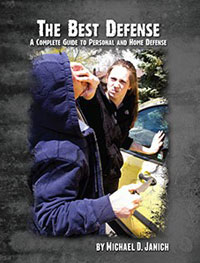 |
THE BEST DEFENSEA Complete Guide To Personal And Home Defense
by Michael D. Janich, co-host of the hit TV series “The Best Defense”
|
![]()
In the first episode of season 7 of The Best Defense (“The Knockout Game”), I taught and applied a great example of practical self-defense against a sudden, unexpected attack. The technique I showed, which I call “Itsy-Bitsy Spider” (you remember, “out comes the sun and dries up all the rain”) is basically an “educated” version of the startle response. When something unexpected flies toward your face, you instinctively respond by raising your hands, hunching your shoulders, and “turtling” your head. That’s Darwin and thousands of years of evolution keeping you safe. The “technique” that I showed is based on the concept of accepting and embracing this instinct and using it as a foundation for a more effective response. Interestingly, this movement can actually be found in a number of traditional Asian martial arts. Unfortunately, many of them teach it as a salutation or a symbolic action to start a form rather than the powerful, easily learned self-defense tactic that it is. Some, like Indonesian pencak silat, “get it” and use this defense as a core technique. That’s smart.
If you watch real fights, one of the other instinctive reactions you’ll see from people who are being punched is to extend both arms to try to hold the attacker at bay. If your arms are substantially longer than your attacker’s this may work. Sadly, in most cases it “brackets” the defender at the exact wrong distance and ensures that he is in range to get hit.
If we accept and embrace this instinct and add a little training to “educate” it, it can become another incredibly powerful self-defense tactic called a “shoulder stop.” Let’s see how it works against one of the most common street attacks: a right roundhouse punch.
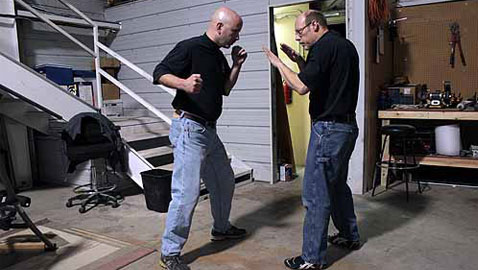
As soon as the attacker prepares to throw a punch, the defender “rides” his natural startle response to get his hands up where they’ll do some good.
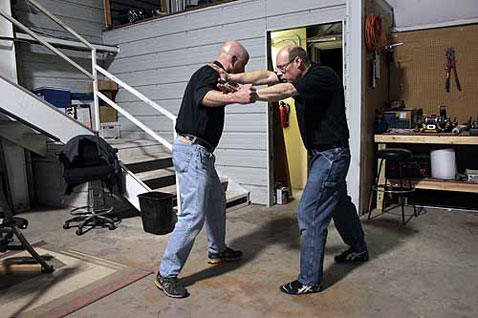
When the defender realizes that a punch is being thrown, he immediately responds with a “shoulder stop”—a powerful simultaneous thrust with both hands. The right palm hits the attacker on or near his shoulder, while the left hand hits somewhere on the arm near the elbow. This response is very instinctive and easily learned, yet will stop even the most powerful punch with ease.
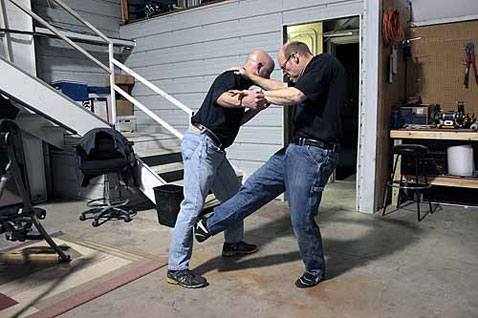
The defender quickly follows with a right kick to the attacker’s shin. This kick is simple and direct and is identical to kicking a soccer ball—just swing your leg hard and kick with the inside edge of your foot against his shin. This will typically cause him to move that leg back and shift his weight to the other leg.
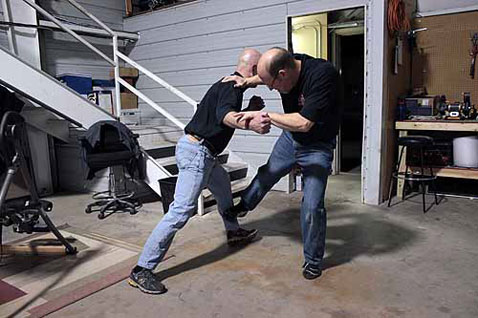
The defender finishes with a stomping side kick to the ankle of the attacker’s other leg. This again uses a powerful weapon—your leg—to destroy your attacker’s ability to stand and fight. And that creates your opportunity to escape.
Good self-defense techniques all share the same qualities. Understand those qualities and make sure that you incorporate them into your personal-defense skill set.
To learn more about my approach to unarmed self-defense, check out my Practical Unarmed Combatives video series from Stay Safe Media. It presents detailed, step-by-step instruction that includes many of the empty-hand tactics you see on The Best Defense.
About Michael Janich:
 Michael Janich is the co-host of The Best Defense and a noted personal-defense instructor, author of numerous books and instructional videos, and founder of the Martial Blade Concepts (MBC) system of edged-weapon tactics. A decorated U.S. Army veteran, Defense Intelligence Agency (DIA) intelligence officer, and former POW/MIA investigation team leader, Janich is also one of the most accomplished videographers in the tactical industry. He is currently the Special Projects Coordinator for the Spyderco knife company and a partner in Stay Safe Media.
Michael Janich is the co-host of The Best Defense and a noted personal-defense instructor, author of numerous books and instructional videos, and founder of the Martial Blade Concepts (MBC) system of edged-weapon tactics. A decorated U.S. Army veteran, Defense Intelligence Agency (DIA) intelligence officer, and former POW/MIA investigation team leader, Janich is also one of the most accomplished videographers in the tactical industry. He is currently the Special Projects Coordinator for the Spyderco knife company and a partner in Stay Safe Media.
To train with Janich and learn more about his classes, click here….






 MidwayUSA
MidwayUSA Ruger Firearms
Ruger Firearms SCCY Firearms
SCCY Firearms Streamlight
Streamlight Action Targets
Action Targets Gunsite Academy
Gunsite Academy
You must be logged in to post a comment Login